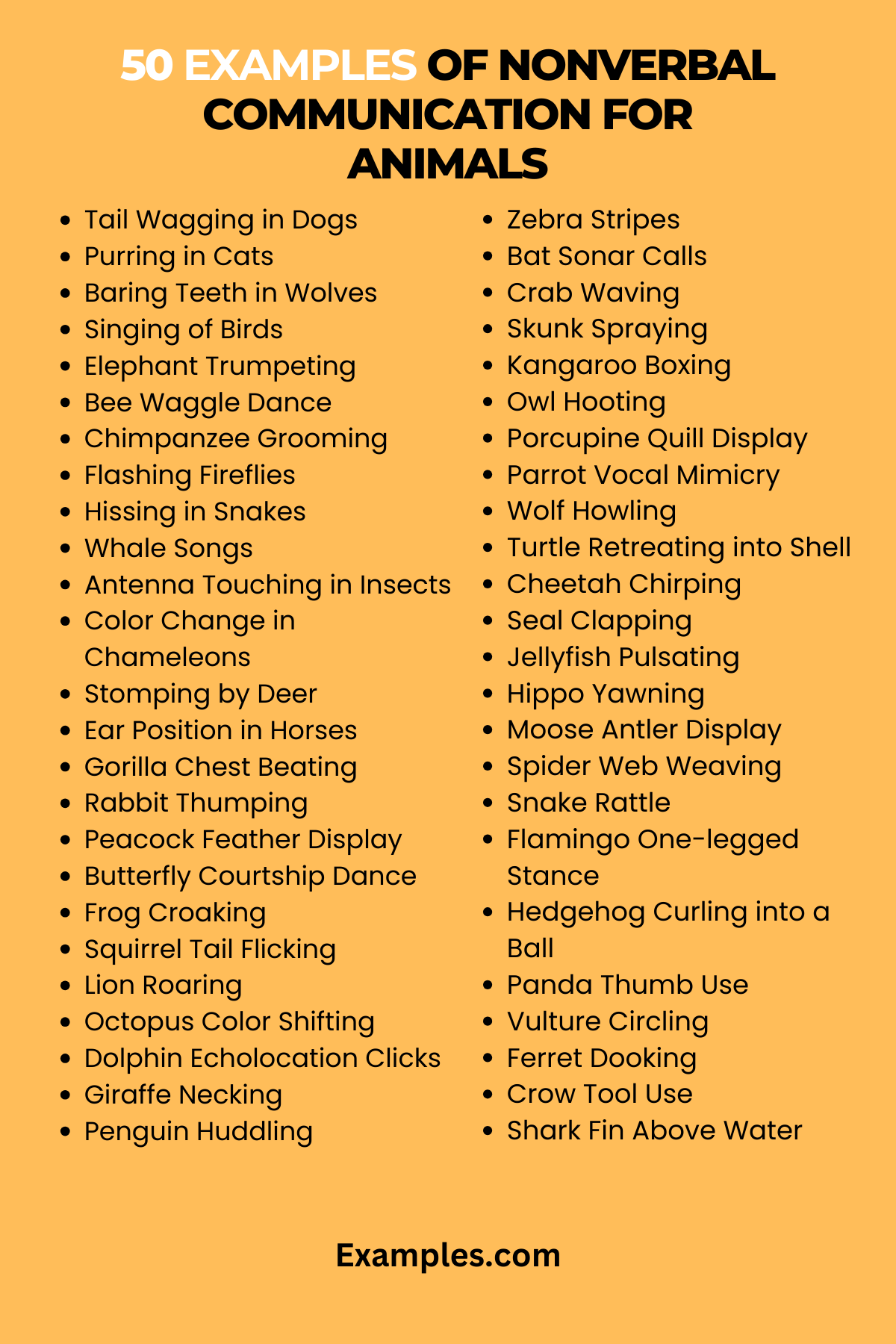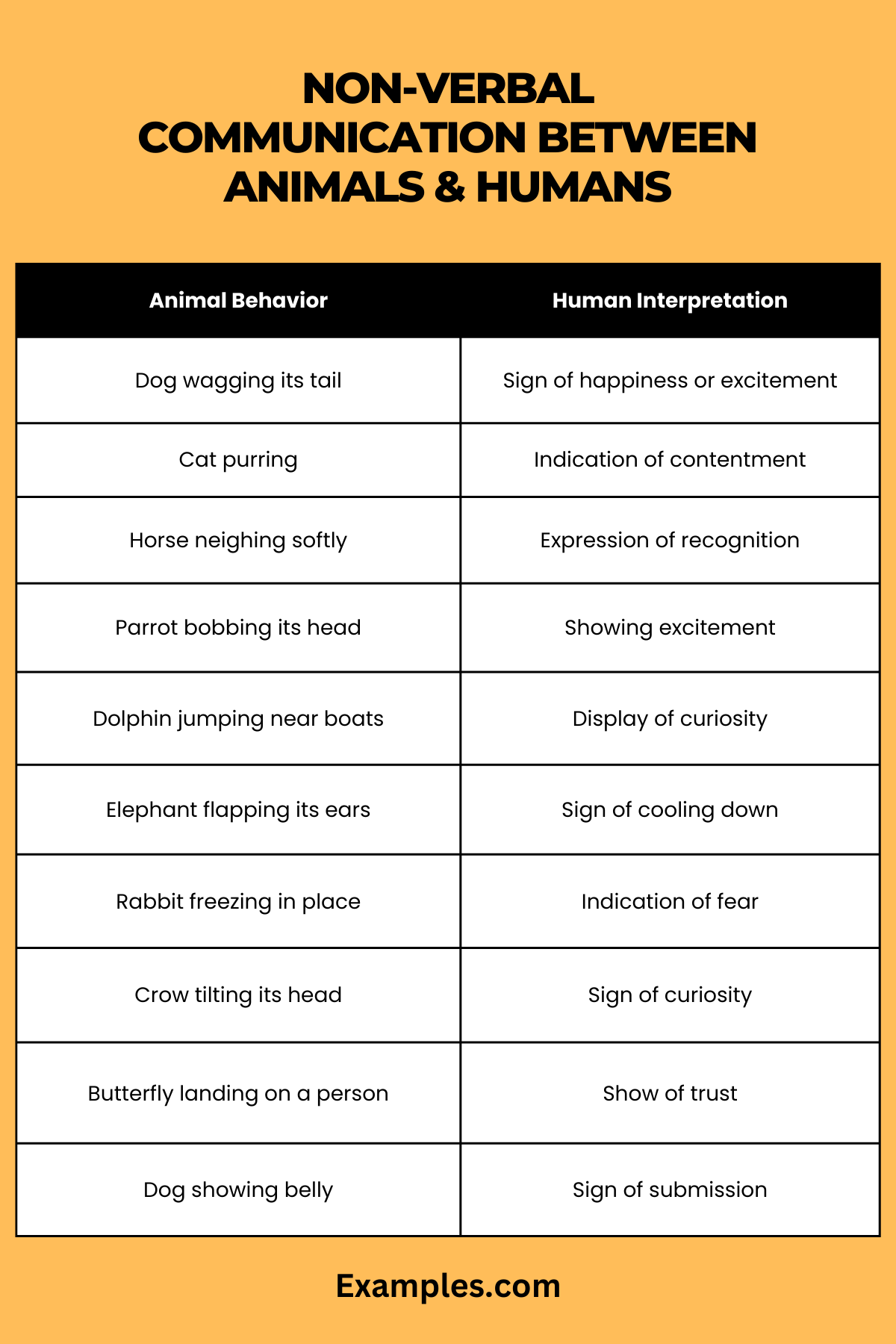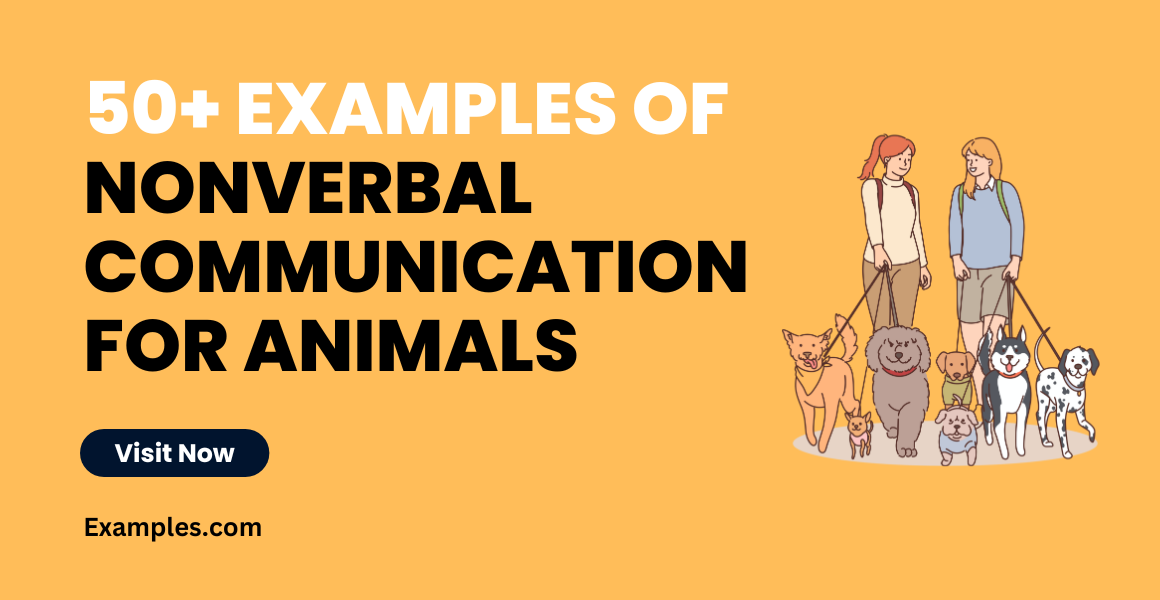Nonverbal Communication for Animals
Nonverbal communication plays a pivotal role in the animal kingdom. This complete guide delves into the fascinating world of animal interactions, offering a wealth of Nonverbal Communication Examples that illustrate how creatures express themselves without words. From the intricate dance of bees to the majestic postures of lions, we explore various forms of nonverbal cues that animals use to convey emotions, intentions, and information. Join us in unraveling these silent yet powerful forms of communication, enhancing your understanding of the animal world.
What is Nonverbal Communication for Animals? – Definition
Nonverbal communication for animals is an essential mode of conveying messages without words. It encompasses a range of behaviors and signals, such as body language, facial expressions, vocal sounds, and scent markings. These nonverbal cues are integral in animal interactions for expressing emotions, establishing social hierarchies, mating rituals, and responding to environmental changes. Such communication is crucial in everyday animal life, as seen in diverse contexts like Nonverbal Communication in Daily Life and Nonverbal Communication for the Birds. Understanding these silent yet expressive forms of communication offers insights into the complex and rich emotional world of animals.
What is the Best Example of Nonverbal Communication for Animals?
One of the most remarkable examples of nonverbal communication in animals is the sophisticated use of body language by elephants. Elephants communicate through subtle movements and postures, such as flapping their ears to express joy or aggression, and gentle trunk touches as a sign of affection. This nonverbal communication is vital in their social interactions, particularly in maintaining family bonds and social structures within herds. Elephants’ ability to convey complex emotions and intentions through body language epitomizes the depth of Nonverbal Communication for Animals, showing how these majestic creatures navigate their social and environmental realms without spoken language. This form of communication is not only crucial for their survival but also enriches our understanding of animal behavior and social dynamics.
50 Examples of Nonverbal Communication for Animals
Dive into the diverse world of animal interactions with our guide on Nonverbal Communication for Animals. This section features 50 unique examples, complete with explanations and Example sentences, showcasing how animals use nonverbal cues in their daily lives, from expressing emotions to social interactions. These examples not only highlight Nonverbal Communication in Daily Life but also illustrate Nonverbal Communication Skills animals possess.

- Tail Wagging in Dogs: Dogs communicate feelings like happiness through tail wagging.
Example: A dog might energetically wag its tail when it sees its owner, a clear sign of its affection and joy. - Purring in Cats: Cats use purring as a way to express contentment.
Example: A cat purring while sitting on your lap shows it’s feeling relaxed and loved. - Baring Teeth in Wolves: Wolves display dominance or aggression by baring teeth.
Example: A wolf baring its teeth during a confrontation is asserting its authority. - Singing of Birds: Birds sing to attract mates or declare territory.
Example: A bird’s melodious song in spring can be a mating call or a territorial claim. - Elephant Trumpeting: Elephants trumpet to express a range of emotions.
Example: An elephant trumpeting loudly can be a signal of danger or excitement. - Bee Waggle Dance: Bees perform dances to indicate food locations.
Example: A bee’s dance can precisely point to the direction and distance of nectar sources. - Chimpanzee Grooming: Chimpanzees groom each other to strengthen social ties.
Example: Chimpanzee grooming is a sign of social bonding and mutual trust. - Flashing Fireflies: Fireflies use light patterns for mating.
Example: A firefly’s light display is its unique way of seeking a mate in the dark. - Hissing in Snakes: Snakes hiss as a defensive signal. Example: A hissing snake is warning others of its readiness to defend itself.
- Whale Songs: Whales use songs for long-distance communication.
Example: Whale songs, often heard over great distances, carry complex social and navigational information.
- Antenna Touching in Insects: Insects, like ants, use their antennae for communication.
Example: Ants touch antennae to share information about food sources or danger. - Color Change in Chameleons: Chameleons change colors to communicate moods or heat.
Example: A chameleon turning bright colors might be signaling its readiness to mate. - Stomping by Deer: Deer stomp their feet as a danger signal.
Example: A deer stomping its foot alerts others to a nearby predator. - Ear Position in Horses: Horses express feelings through ear movements.
Example: A horse with ears forward is curious or attentive, while ears pinned back show annoyance. - Gorilla Chest Beating: Gorillas beat their chests to show dominance or attract mates.
Example: A male gorilla’s chest beating can intimidate rivals or impress potential mates. - Rabbit Thumping: Rabbits thump their hind legs as an alarm.
Example: A rabbit thumping on the ground signals to others that danger is near. - Peacock Feather Display: Peacocks fan their feathers to attract females.
Example: A peacock spreading its vibrant tail is showcasing its fitness to potential mates. - Butterfly Courtship Dance: Butterflies perform aerial dances during mating.
Example: Butterflies swirling around each other in flight is part of their mating ritual. - Frog Croaking: Frogs croak to attract mates or mark territory.
Example: A frog’s loud croak during the rainy season is a call for mating. - Squirrel Tail Flicking: Squirrels flick their tails as a warning or signal.
Example: A squirrel flicking its tail rapidly might be signaling distress or alerting others. - Lion Roaring: Lions roar to communicate power and territorial control.
Example: A lion’s roar, heard for miles, can signify its presence and dominance. - Octopus Color Shifting: Octopuses change color for camouflage or communication.
Example: An octopus shifting colors rapidly could be signaling agitation or preparing to hunt. - Dolphin Echolocation Clicks: Dolphins use clicks for navigation and communication.
Example: Dolphins emit rapid clicks to locate objects or communicate with the pod. - Giraffe Necking: Giraffes use neck swings to establish dominance.
Example: Two giraffes swinging their necks in combat are determining hierarchy within the group. - Penguin Huddling: Penguins huddle for warmth and social bonding.
Example: Penguins forming a tight group in cold conditions share warmth and strengthen social ties. - Zebra Stripes: Zebras’ stripes can confuse predators and signal health.
Example: A zebra’s distinct stripes may deter predators through optical illusions. - Bat Sonar Calls: Bats emit sonar calls for navigation and prey location.
Example: Bats use high-pitched calls to navigate in the dark and locate insects. - Crab Waving: Crabs wave their claws to attract mates or deter rivals.
Example: A crab waving its larger claw is either courting a mate or warning other crabs. - Skunk Spraying: Skunks spray as a defensive mechanism.
Example: A skunk’s spray is its ultimate weapon against predators, emitting a pungent odor. - Kangaroo Boxing: Kangaroos box to establish dominance or compete for mates.
Example: Male kangaroos engage in boxing as a show of strength and dominance. - Owl Hooting: Owls hoot to communicate territory or attract mates.
Example: An owl’s hoot at night can be a territorial claim or a mating call. - Porcupine Quill Display: Porcupines raise quills to intimidate threats.
Example: A porcupine with raised quills is signaling it’s ready to defend itself. - Parrot Vocal Mimicry: Parrots mimic sounds and voices for interaction.
Example: A parrot repeating words or sounds is engaging with its environment or seeking attention. - Wolf Howling: Wolves howl for long-distance communication within the pack.
Example: A wolf’s howl can reunite scattered pack members or mark territory. - Turtle Retreating into Shell: Turtles retreat into their shells for protection.
Example: A turtle withdrawing into its shell is a clear sign of feeling threatened. - Cheetah Chirping: Cheetahs chirp to communicate with cubs or siblings.
Example: A cheetah’s chirp can call its cubs or coordinate with family members. - Seal Clapping: Seals clap underwater to communicate or show strength.
Example: A seal clapping its flippers might be attracting a mate or scaring off rivals. - Jellyfish Pulsating: Jellyfish pulse to move and communicate.
Example: A jellyfish’s rhythmic pulsing is part of its locomotion and can signal its presence to others. - Hippo Yawning: Hippos yawn to display size and strength.
Example: A hippo’s large yawn can be a warning sign, showcasing its large teeth as a deterrent. - Moose Antler Display: Moose use their antlers to display strength and vitality.
Example: A moose showcasing its antlers during the rut is a sign of dominance and mating readiness. - Spider Web Weaving: Spiders weave intricate webs as traps and territorial markers.
Example: A spider’s web not only captures prey but also signals its presence to other spiders. - Snake Rattle: Rattlesnakes use their tail rattle as a warning.
Example: A rattlesnake’s distinctive rattle sound is a clear indication to back off. - Flamingo One-legged Stance: Flamingos stand on one leg to conserve body heat. Example: A flamingo standing on one leg is regulating its body temperature, not just resting.
- Hedgehog Curling into a Ball: Hedgehogs curl into a ball for protection. Example: A hedgehog curls up tightly to shield itself from predators.
- Panda Thumb Use: Pandas use an enlarged wrist bone as a thumb for gripping bamboo.
Example: A panda’s ‘thumb’ enables it to grasp and eat bamboo efficiently. - Vulture Circling: Vultures circle overhead to locate carrion.
Example: Vultures circling in the sky are often an indicator of a nearby carcass. - Ferret Dooking: Ferrets make a “dooking” sound when happy or excited.
Example: A ferret’s playful dooking noises indicate it’s content and energetic. - Crow Tool Use: Crows use tools for foraging and problem-solving.
Example: A crow manipulating sticks or objects demonstrates its remarkable intelligence and adaptability. - Shark Fin Above Water: Sharks display their fin above water as a hunting behavior.
Example: A shark’s fin protruding above water can be a sign of hunting or exploring. - Manta Ray Leaping: Manta rays leap out of water for communication or parasite removal.
Example: A manta ray jumping out of the water might be communicating with others or ridding itself of skin parasites.
Each of these examples illustrates the rich tapestry of Nonverbal Communication for Animals, highlighting their ability to convey complex messages without words. Understanding these nonverbal cues deepens our appreciation and understanding of the animal kingdom.
How do Animals Use Communication?
Animals use communication as a fundamental tool for survival, social interaction, and expressing emotions. In the realm of Nonverbal Communication for Animals, these interactions occur through various means, bypassing the need for spoken words. Animals communicate for several reasons:
- Expressing Emotions and Intentions: Animals display fear, aggression, affection, and curiosity through body language, vocalizations, and facial expressions. For example, a dog wagging its tail or a cat purring are classic indicators of happiness or contentment.
- Social Bonding and Hierarchies: Many species use nonverbal cues to establish social structures or create bonds. Wolves, for instance, have a complex hierarchy communicated through postures and eye contact.
- Territorial and Mating Signals: Animals often use nonverbal communication to mark territories or attract mates. The bright plumage of a peacock or the distinct call of a songbird during mating season are prime examples.
- Warning and Defense Mechanisms: Nonverbal signals can also serve as warnings. A rattlesnake’s rattle or a porcupine’s raised quills are nonverbal cues indicating a defensive stance.
- Navigational and Foraging Cues: Animals like bees and ants communicate locations of food sources through dances and pheromone trails, respectively.
Understanding these methods of nonverbal communication helps in comprehending the complex and interconnected world of animal behavior.
Non-Verbal Communication Between Animals & Humans

| Animal Behavior | Human Interpretation | Communication Purpose |
|---|---|---|
| Dog wagging its tail | Sign of happiness or excitement | Expressing joy or welcoming gesture |
| Cat purring | Indication of contentment or self-soothing | Signaling comfort, trust, or need for attention |
| Horse neighing softly | Expression of recognition or greeting | Communicating recognition or initiating interaction |
| Parrot bobbing its head | Showing excitement or playfulness | Engaging in playful behavior or seeking attention |
| Dolphin jumping near boats | Display of curiosity or playfulness | Demonstrating curiosity or engaging in playful interaction |
| Elephant flapping its ears | Sign of cooling down or agitation | Regulating body temperature or expressing discomfort |
| Rabbit freezing in place | Indication of fear or alertness | Signaling awareness of potential danger |
| Crow tilting its head | Sign of curiosity or focus | Examining objects or people, showcasing intelligence |
| Butterfly landing on a person | Show of trust or lack of threat | Seeking rest or indicating human is not perceived as a threat |
| Dog showing belly | Sign of submission or trust | Expressing trust and seeking affection |
This table showcases the diverse ways in which animals communicate nonverbally with humans, reflecting a blend of trust, curiosity, and emotional expression. These interactions highlight the importance of understanding Nonverbal Communication for Animals, fostering better relationships and deeper connections between humans and animals.
How Animals Understand Our Nonverbal Communication
Animals have a remarkable capability to interpret human nonverbal cues, a skill essential for their interaction with us. This understanding impacts interactions ranging from domestic pets to wildlife encounters. Key ways animals comprehend our nonverbal signals include:
- Body Language Interpretation: Animals, especially pets like dogs and cats, are adept at reading human body language. They can gauge emotions like happiness or stress through our posture and gestures.
- Emotional Perception: Animals often sense human emotions through nonverbal cues. For instance, a dog might offer comfort by sensing sadness in its owner, showcasing Nonverbal Communication Skills.
- Visual Cues Recognition: Eye contact and facial expressions are significant for animals. Horses, for example, can read human facial expressions, reacting accordingly, a concept linked with Nonverbal Communication in Daily Life.
- Vocal Tone Sensitivity: The tone of our voice conveys various messages to animals. A gentle tone may calm a pet, while a louder tone might indicate authority or alarm, similar to Nonverbal Communication at Workplace scenarios.
- Consistency in Gestures: Regular gestures help animals understand human behavior, akin to teaching Nonverbal Communication for Teachers or trainers.
Understanding these aspects of animal perception of human nonverbal communication can lead to more effective and empathetic interactions with them.
Types of Nonverbal Communication for Animals
Nonverbal communication in animals is diverse, encompassing behaviors and signals crucial for their survival and interaction. Key types include:


- Visual Signals: Utilized extensively in the animal kingdom. The peacock’s feather display is a classic Nonverbal Communication Symbol.
- Auditory Signals: This includes varied sounds like the wolf’s howl or a bird’s song, essential for communication within many species. It’s comparable to Nonverbal Communication in Movies, where sound plays a key role in conveying emotions.
- Tactile Communication: Physical touch, vital in species like primates, echoes the importance of touch in Nonverbal Communication for Autism, where tactile sensations can be significant.
- Chemical Signals: Animals, especially insects like ants, use pheromones, similar to humans relying on subtle Nonverbal Communication Skills like scent.
- Electrical Signals: Unique to aquatic species, this form of communication is as pivotal as Nonverbal Communication Symbols in human interactions.
Each type demonstrates the intricate ways animals convey messages, paralleling various forms of human nonverbal communication, such as in Nonverbal Communication in Different Cultures or Nonverbal Communication Examples in School. Understanding these types enriches our knowledge of animal behavior and their sophisticated communication systems.
In conclusion, understanding the examples and types of Nonverbal Communication for Animals offers invaluable insights into their complex world. This guide illuminates how animals express emotions, establish social dynamics, and interact with humans, enhancing our appreciation of their intelligence and emotional depth. Embracing these nonverbal cues can deepen our connection with the animal kingdom and foster more empathetic and informed interactions.


